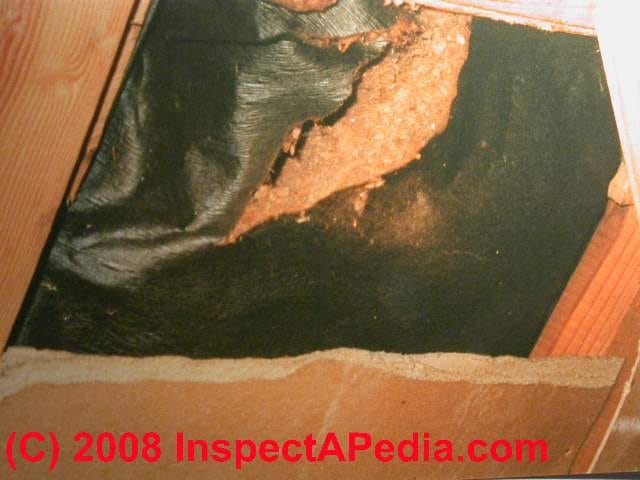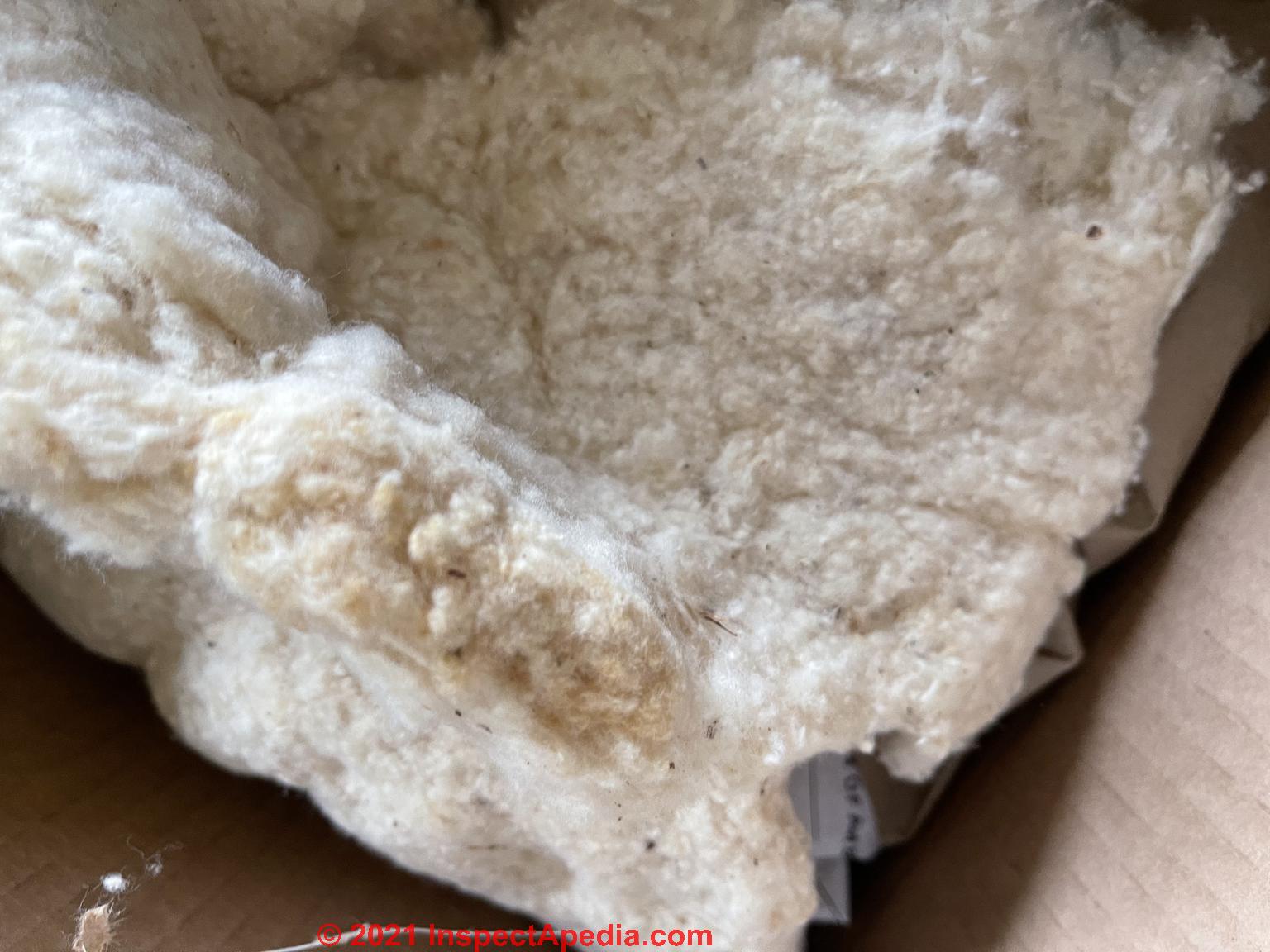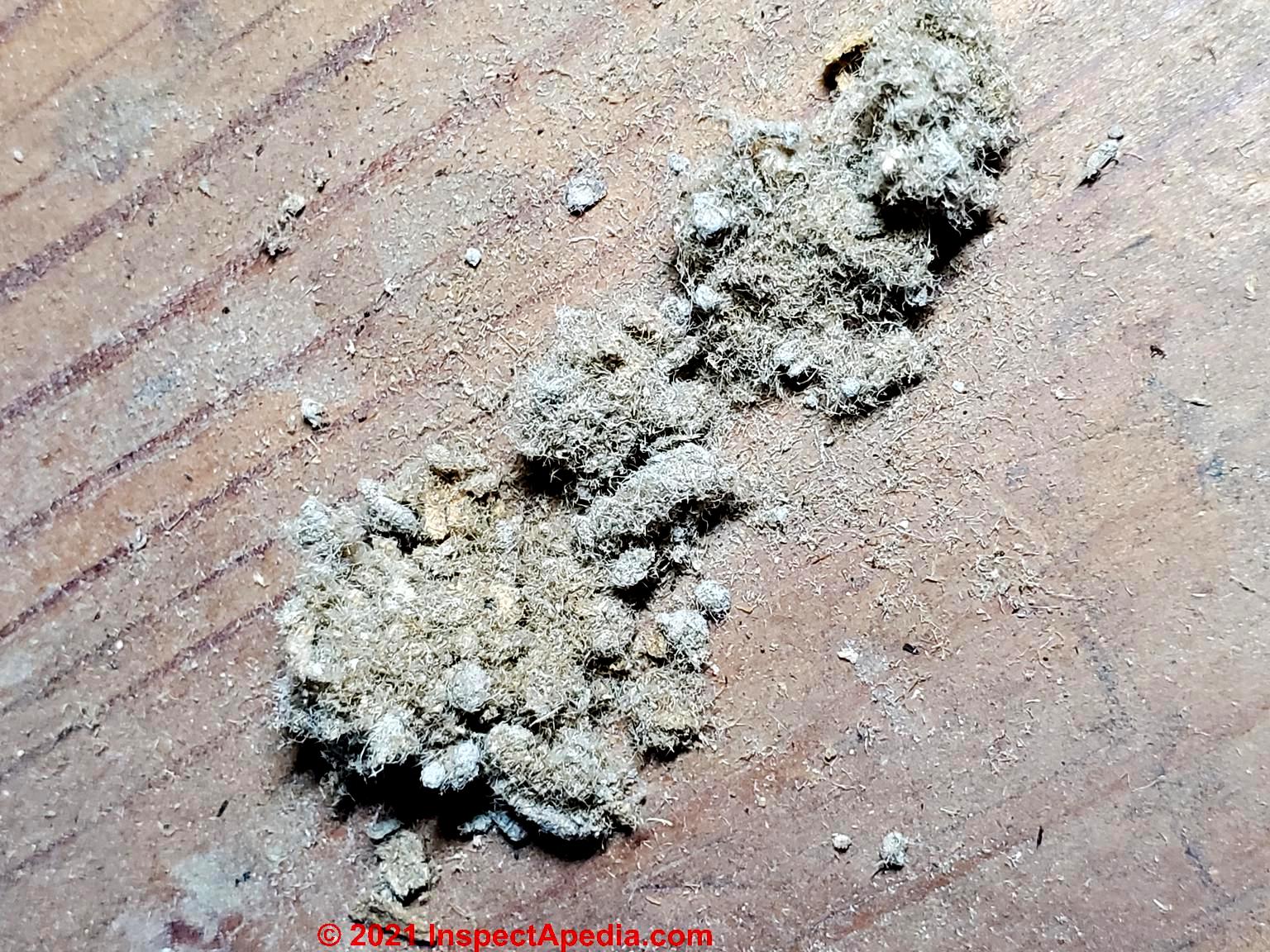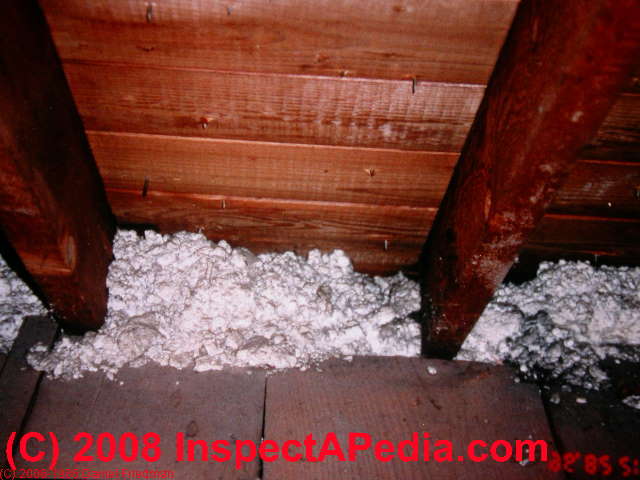 Identify Building
Insulation Products Not Likely to Contain Asbestos
Identify Building
Insulation Products Not Likely to Contain Asbestos
These non-asbestos insulation products
may be mistaken for Asbestos
- POST a QUESTION or COMMENT about identifying asbestos-free building insulation materials
Guide to asbestos-free building insulation products: this non-asbestos insulation article illustrates and describes common insulation materials that would not be expected to contain asbestos.
We include photographs that can help you identify common building materials that are unlikely to have ever contained asbestos.
InspectAPedia tolerates no conflicts of interest. We have no relationship with advertisers, products, or services discussed at this website.
- Daniel Friedman, Publisher/Editor/Author - See WHO ARE WE?
Asbestos-Free Insulation Materials
Examples of materials that do not commonly contain asbestos but might be mistaken for asbestos-containing substances
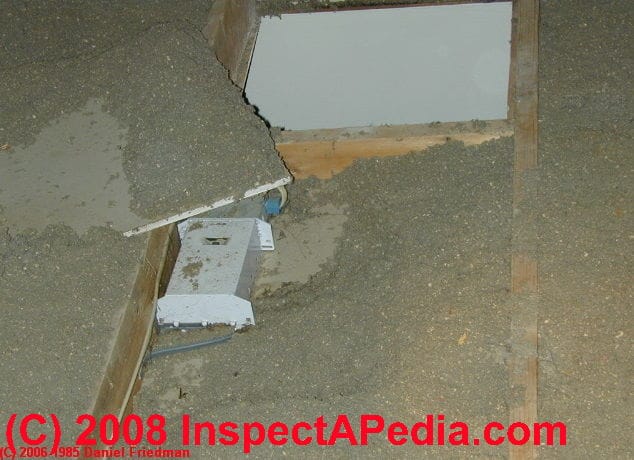
Our photo at above is of blown-in cellulose insulation. The links just below under the green heading provide articles describing building insulation materials that would not be expected to contain asbestos.
Our page top photo shows mineral wool insulation in a building attic - mineral wool or "rock wool" is not expected to be an asbestos-containing material.
To identify all types of building insulation, see INSULATION IDENTIFICATION GUIDE or the detailed links listed at the ARTICLE INDEX the bottom of this article .
Balsam wool is a wood or cellulose product discussed in detail at Balsam Wool Batt Insulation. See that article for more about asbestos questions concerning this wood product material.
These non-asbestos insulations include cellulosic insulations such as loose-fill cellulose and balsam wool batts, cotton insulation, fiberglass insulation, mineral wool insulation, slag wool insulation, and rock wool insulation.
Other older building insulation materials such as corn cobs, newspaper, bricks, and simple reflective barriers using aluminum foil also would not be expected to contain asbestos.
Also see ASBESTOS IDENTIFICATION IN BUILDINGS That article describes, lists, and provide identification photos of building materials that are likely to contain asbestos.
Solid Foam Product Insulating Products - Rigid Polystyrene, Polyurethane, Polyisocyanurate Insulation Characteristics
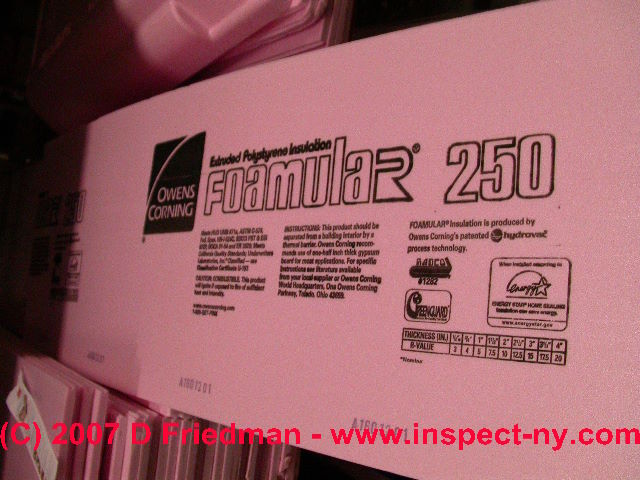 Solid Foam Product Insulating Products - Rigid Polystyrene, Polyurethane, Polyisocyanurate Insulation products will not contain asbestos fibers and most of these products are rather mold resistant, possibly because of their chemistry or because closed-cell foam insulations simply do no take up and hold the moisture that is required for active mold growth on or in building insulations or surfaces.
Solid Foam Product Insulating Products - Rigid Polystyrene, Polyurethane, Polyisocyanurate Insulation products will not contain asbestos fibers and most of these products are rather mold resistant, possibly because of their chemistry or because closed-cell foam insulations simply do no take up and hold the moisture that is required for active mold growth on or in building insulations or surfaces.
What are the Insulation R-Values of Foam Insulation Boards?
Expanded, extruded, and cut bead polystyrene insulation products have an R-value of about 4.0 per inch of thickness.
Typical exterior foam board building insulation sheets have an R-value of 2.64 per inch.
Expanded polyurethane building insulation products have an R-value of about 5.0 per inch of thickness. Expanded polyurethane insulation expanded using the refrigerant gas has an R-value of about 6.25 per inch.
Polyisocyanurate insulation products have an R-value of about 7.04 per inch.[ASHRAE Fundamentals Handbook.]
To compare insulating material R-values see our Table of Properties of Insulating Materials
Mold on Foam Insulation: Explanation & Assessment of the Growth of Mold on Solid Foam Insulation Products
However we have observed surface mold growth on polystyrene foam board insulation.
In those instances where we found mold on foam rigid insulating boards it has sometimes been due to the combination of exposure to wet conditions and the presence of organic dust and debris on the surface of the foam.
We've seen these mold-friendly conditions producing mold on foam insulation materials (and on even less mold-friendly materials like metal or glass or un-painted masonry block foundation walls) where the insulation surface was wet, kept in a wet or very humid environment, and was dusty or dirty.
This is a probable explanation for the frequent discovery of mold in building air conditioning air handlers or blower compartments. In air handlers condensate over spray is often blown around in the blower compartment.
There are mold species that can grow on just about anything; but the presence of hair, skin cells, and other organic debris on building surfaces may explain why we find more mold growth on foam board insulation in one location and no mold growth on the same building product used somewhere else. Usually the mold we identify in building air handlers is a species of Cladosporium sp. - called the "king of molds" because molds in this family are so widespread outdoors.
Cladosporium sp. is not without its own health concerns for some building occupants, but when this mold is found indoors it may be more important to determine why it is there and therefore to determine the chances that other, more toxic and more easily airborne mold genera/species are present in the same building.
Also see MOLD in FOAM INSULATION, RESISTANCE,
Also see Mold On Foam Insulation for a discussion of when and why we find mold growth on foam insulating materials like foam board and air handler foam insulating board.
Spray Icynene Foam Building Insulation Identification in buildings
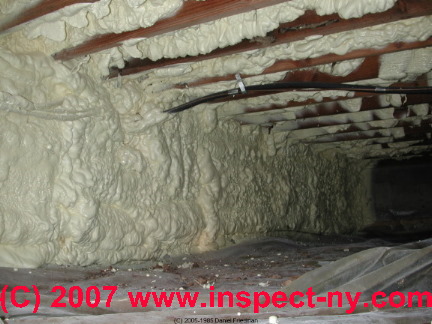 Some mold-suspect material in buildings is easily determined to be spray foam insulation.
Some mold-suspect material in buildings is easily determined to be spray foam insulation.
Sprayed icynene foam insulation is not mold either.
Though we sometimes find fungal growth in buildings that looks a lot like this substance, it would be very odd for it to appear so extensively and so uniformly as the foam insulation shown in this photo.
This is a sprayed-on icynene foam insulation project that was completed in a crawlspace. Because the work area was tight, it was difficult for the foam spraying technician to work meticulously but s/he did a pretty nice job.
Using a combination of visual inspection and smoke testing we found only two openings in the foam blanket that were permitting air movement from the crawl space up into the living space. Overall it was an effective installation.
In the ARTICLE INDEX given below we include more articles helpful if you need to identify
- Balsam wool (Balsam Wool Batt Insulation)
- Sellulose insulation (Cellulose loose fill insulation) ,
- Foam insulation products (FOAM SPRAY INSULATION TYPES) and
- other insulation materials, and we include a comprehensive list of non-asbestos insulation products used on or in buildings.
...
Reader Comments, Questions & Answers About The Article Above
Below you will find questions and answers previously posted on this page at its page bottom reader comment box.
Reader Q&A - also see RECOMMENDED ARTICLES & FAQs
On2021-03-09 by Chris - Identify insulation - packing made in China
I purchased fine China from someone online and when I open the box this material was used for packing. What is it?
On 2021-03-09 - by (mod)
@Chris, I'm not sure; it looks like a cotton or (less likely) fiberglass insulating blanket or packing material.
On 2020-11-22 - by (mod) -
Jesse
InspectAPedia.com is a free online Encyclopedia of Building & Environmental Inspection, Testing, Diagnosis, Repair that
provides building and environmental diagnostic and repair information.
In order to absolutely assure our readers that we write and report without bias we do not sell any products nor services, nor do we have any business or financial relationships that could create such conflicts of interest. InspectAPedia is an independent publisher of building, environmental, and forensic inspection, diagnosis, and repair information for the public - we have no business nor financial connection with any manufacturer or service provider discussed at our website. We very much welcome critique, questions, or content suggestions for our web articles.
More about us is at ABOUT InspectApedia.com
On 2020-11-18 by Jesse - check my photo: is this insulation asbestos?
I just want to know it is contents asbestos for my family health.
I tried to burn it, did not have any flame and just amber with little smoke when black.
Reply by (mod)
Yoiur photo is a bit blurry but it seems tho show a mix of sawdust and what looks like mineral wool insulation.
On 2020-11-18 y Jesse
Thank you so much for your prompt care!
On 2017-07-04 by Dave5 - Does the wall lath in a 100 year old house contain asbestos?
Is there asbestos in wall lathe in a 100 year old house
On 2017-07-05 - by (mod) - no but ...
The actual lath behind and supporting the plaster in a 100 year old house is most likely wood.
Later some installes used expanded metal mesh.
Of course over the100 year life of your building someone could and probably would have patched cracks or loose plaster.
IF the repair person used joint compound to make minor repairs, depending on where that substance was manufactured and when, it could contain asbestos.
...
Continue reading at INSULATION IDENTIFICATION GUIDE - topic home, or select a topic from the closely-related articles below, or see the complete ARTICLE INDEX.
Or see these
Recommended Articles
ASBESTOS IDENTIFICATION IN BUILDINGS
Suggested citation for this web page
ASBESTOS-FREE INSULATION MATERIALS at InspectApedia.com - online encyclopedia of building & environmental inspection, testing, diagnosis, repair, & problem prevention advice.
Or see this
INDEX to RELATED ARTICLES: ARTICLE INDEX to BUILDING INSULATION
Or use the SEARCH BOX found below to Ask a Question or Search InspectApedia
Ask a Question or Search InspectApedia
Questions & answers or comments about finding, using, diagnosing, repairing, or replacing water pressure gauges on private well systems.
Try the search box just below, or if you prefer, post a question or comment in the Comments box below and we will respond promptly.
Search the InspectApedia website
Note: appearance of your Comment below may be delayed: if your comment contains an image, photograph, web link, or text that looks to the software as if it might be a web link, your posting will appear after it has been approved by a moderator. Apologies for the delay.
Only one image can be added per comment but you can post as many comments, and therefore images, as you like.
You will not receive a notification when a response to your question has been posted.
Please bookmark this page to make it easy for you to check back for our response.
IF above you see "Comment Form is loading comments..." then COMMENT BOX - countable.ca / bawkbox.com IS NOT WORKING.
In any case you are welcome to send an email directly to us at InspectApedia.com at editor@inspectApedia.com
We'll reply to you directly. Please help us help you by noting, in your email, the URL of the InspectApedia page where you wanted to comment.
Citations & References
In addition to any citations in the article above, a full list is available on request.
- 3/07: thanks to Gary Randolph, Ounce of Prevention Home Inspection, LLC Buffalo, NY, for attentive reading and editing suggestions. Mr. Randolph can be reached in Buffalo, NY, at (716) 636-3865 or email: gary@ouncehome.com
- Asbestos Identification, Walter C.McCrone, McCrone Research Institute, Chicago, IL.1987 ISBN 0-904962-11-3. Dr. McCrone literally "wrote the book" on asbestos identification procedures which formed the basis for current work by asbestos identification laboratories. Stanton, .F., et al., National Bureau of Standards Special Publication 506: 143-151
- In addition to citations & references found in this article, see the research citations given at the end of the related articles found at our suggested
CONTINUE READING or RECOMMENDED ARTICLES.
- Carson, Dunlop & Associates Ltd., 120 Carlton Street Suite 407, Toronto ON M5A 4K2. Tel: (416) 964-9415 1-800-268-7070 Email: info@carsondunlop.com. Alan Carson is a past president of ASHI, the American Society of Home Inspectors.
Thanks to Alan Carson and Bob Dunlop, for permission for InspectAPedia to use text excerpts from The HOME REFERENCE BOOK - the Encyclopedia of Homes and to use illustrations from The ILLUSTRATED HOME .
Carson Dunlop Associates provides extensive home inspection education and report writing material. In gratitude we provide links to tsome Carson Dunlop Associates products and services.


